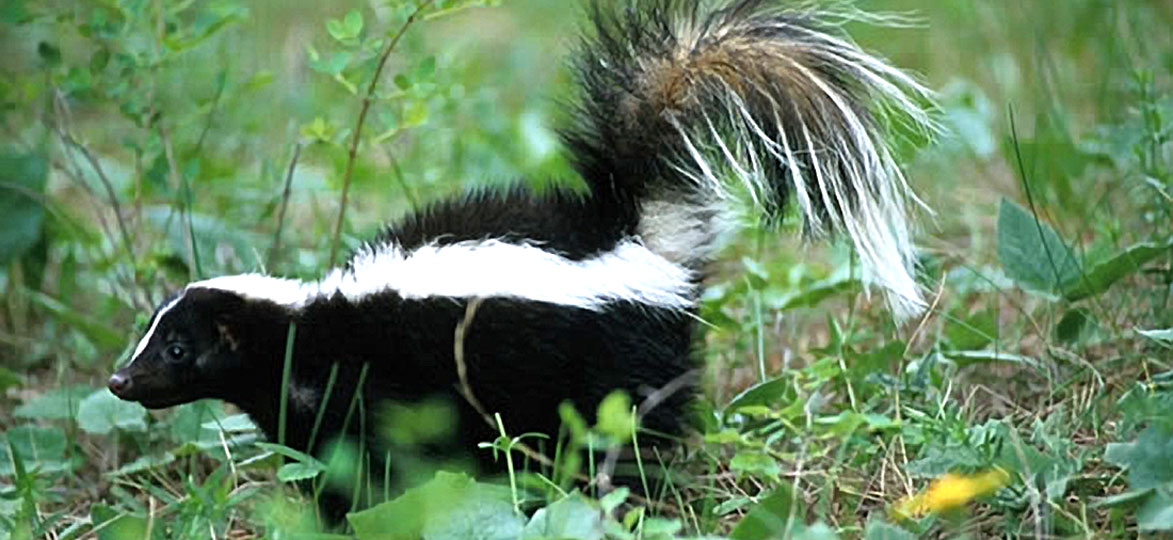
The striped skunk (Mephitis mephitis) is a highly adaptable animal that can thrive in a wide variety of habitats as long as food and shelter are available, and it is within about two miles of a water source. It is easily recognized by the white stripe running from its head to its tail and is well known for its ability to spray an unpleasant scent to ward off potential threats.
Habits and Habitat
Striped skunks are found in a variety of habitats including fields, forests, grasslands and brushy open areas. They are also commonly found inhabiting urban and suburban areas.
Most active from sunset to sunrise, striped skunks are considered to be both crepuscular and nocturnal. They are not true hibernators but will den up in a hollow log or abandoned building and become inactive during long stretches of cold weather. They may share a den with other females and even a single male at this time to conserve body heat. Usually solitary, this may be the only time when a male and female are together other than during the breeding season.
Since striped skunks are not adept climbers or fast runners, they defend themselves by spraying their attackers with an oily, foul-smelling musk. In addition to the pungent odor, the liquid can cause severe pain and even temporary blindness. When threatened, a skunk will first try to run away, but if that doesn’t work it hisses, arches its back, raises its tail, and turns its back on the predator. The skunk will move backwards towards the aggressor while stamping its feet. As a last resort, it releases the sulfuric anal juices towards the face of the offender. Skunks can spray up to 15 feet, but the smell can carry up to a mile.
Because striped skunks are abundant, their populations are often susceptible to diseases such as rabies. Rabid skunks are dangerous and should be avoided. Their behavior is much different from that of healthy skunks. Some characteristics of infected skunks are activity during the day, aggression, or being unlikely to spray. An animal control officer should be contacted so that the animal can be properly dealt with.
Reproduction
Breeding occurs from February through late March. The male will mate with more than one female in a breeding season, but the female will mate with only one male. The female skunk may build a nest under a wood pile or in an abandoned building, dig a den in a bank, or inhabit a burrow abandoned by another animal, such as a woodchuck.
After a gestation period of approximately 63 days, the young are born in late April to early June. Litter size varies from two to ten young, with the average being six to seven. The young are born sightless and covered with fur that already has the tell-tale markings of the adult striped skunk.
The female is protective of her young, even carrying them around in her mouth. After four weeks, the young open their eyes. Weaning occurs from six to eight weeks of age. The female raises the young, and it is not uncommon to see the family out feeding on a summer night. The young leave home in the fall or the following spring to breed and raise a family of their own. The female skunk becomes sexually mature at the age of one year.
Diet
The striped skunk is an omnivore, eating both plants and animals. It is an opportunist by nature, depending on the season and food availability. Its diet includes insects, beetles, crickets, grasshoppers, small mammals, birds, eggs, vegetation, and garbage. The striped skunk's willingness to eat garbage has allowed it to spread into towns and cities and it is even known to eat unattended dog and cat food
The skunk forages at night aggressively searching out food guided by its strong sense of smell. It spends much of its time digging for insects and burrowing animals.
Management
The striped skunk population in Vermont is monitored through regulated hunting and trapping seasons. There is no closed season for hunting skunks but the trapping season is open for approximately two months, running from late October through the end of December.
Status
Skunks are abundant in Vermont. Their populations fluctuate from year to year, depending on food availability, seasonal and climatic conditions and disease.
